-
Posts
2698 -
Joined
-
Last visited
-
Days Won
6
Content Type
Profiles
Forums
Gallery
Events
Posts posted by Alan
-
-
(Unfortunately, I have chosen to remove this content due to unchecked behaviors by others on this board. My apologies to those who will not benefit from it in the future.)
-
(Unfortunately, I have chosen to remove this content due to unchecked behaviors by others on this board. My apologies to those who will not benefit from it in the future.)
-
I took a lot of photos at the New Philly show and thought that I would share them with others. It was a very good show with quite a quantity and array of quality marbles for sale. Kudos to Steve Smith for putting it all together. Enjoy the pics!
Alan
(Unfortunately, I have chosen to remove this large amount content due to unchecked behaviors by others on this board. My apologies to those who will not benefit from it in the future.)
-
(Unfortunately, I have chosen to remove this content due to unchecked behaviors by others on this board. My apologies to those who will not benefit from it in the future.)
-
chucks_mibs said:Does anyone know how much glass was used for a particular run?....The reason I'm asking is because Large chunks of cullet....(some cases 45 pounds) have been sold on eBay on a regular basis (do a search for "cullet" under marbles). Some of these chunks of cullet already have the glass mixed and in some cases the flame pattern already in the glass....I really don't know the whole process by which the marbles were made, but you could figure that if some of the flames were done intentionally, perhaps the glass was placed in the vat in layers to give the flame effect reminiscent of the large pieces of cullet found. Here are some pics of cullet being sold on eBay right now. The first one being the 45lbs specimen......I understand that tanks as well as the nozzles were cleaned to put different colors in between runs and that glass was discarded, but look at the layers of glass in that chunk.....why would they waste that much glass.....
I have a theory that perhaps the glass was layered like this on purpose before it reached the nozzles to make flames and other intricate designs.......Anyone care to elaborate??
PS- This seller is from Arkansas and appears to have a lot of Large Cullet pieces that favor Glass used by WVS companies
(Unfortunately, I have chosen to remove this content due to unchecked behaviors by others on this board. My apologies to those who will not benefit from it in the future.)
-
(Unfortunately, I have chosen to remove this content due to unchecked behaviors by others on this board. My apologies to those who will not benefit from it in the future.)
-
Here's an adorable box which recently sold on ebay. Looks like it was packaged for the British market but all it says about the marbles are that they are foreign. I first guessed the marbles would be German, but then I wondered about Japanese or American. We would all qualify as foreign if the box was to be sold in England. What do you think?
(source)
IIRC the Fairlylite toy company was owned by the Graham Brothers in the UK. It manufacturerd and imported from Japan. The logo below looks like a match to yours:
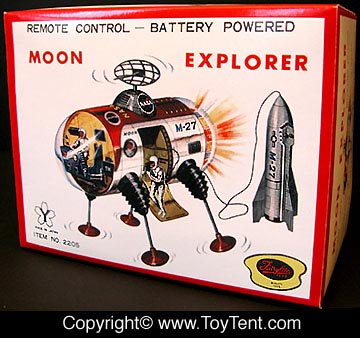
-
The thought crosses my mind that it would not be inconceivable for it to be Jabo.
-
(Unfortunately, I have chosen to remove this content due to unchecked behaviors by others on this board. My apologies to those who will not benefit from it in the future.)
-
For a "hand gathered" marble - the gaffer picks up a quantity of hot glass on the end of a steel rod (known as a punty) using a circular motion. That hot (and flowing) glass is then held over the marble machine and is allowed to drip at a reasonably constant flow rate into a machine which takes a small portion of the hot glass and rounds it into a sphere. A helper stands near the hot glass gather with glass shears to cut the appropriate quantitiy of glass for each marble.
In a handmade marble - a cane of glass is slowly constructed in a series of successive steps to build a design in the form of a cylinder on the end of a punty. For a Latticinio core swirl or example - the gaffer would pick up a quantity of clear glass and begin to gradually form it into a cylinder - perhaps 4" in diameter or so.
This is Harry Bessett demonstrating at Wheaton Village:
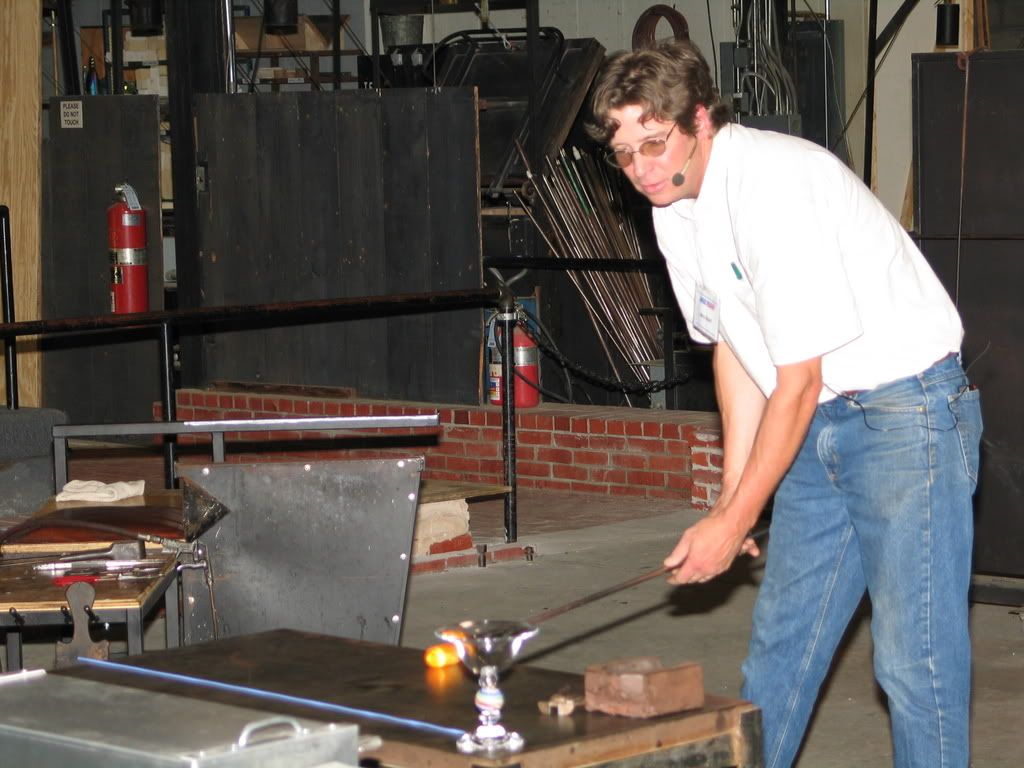
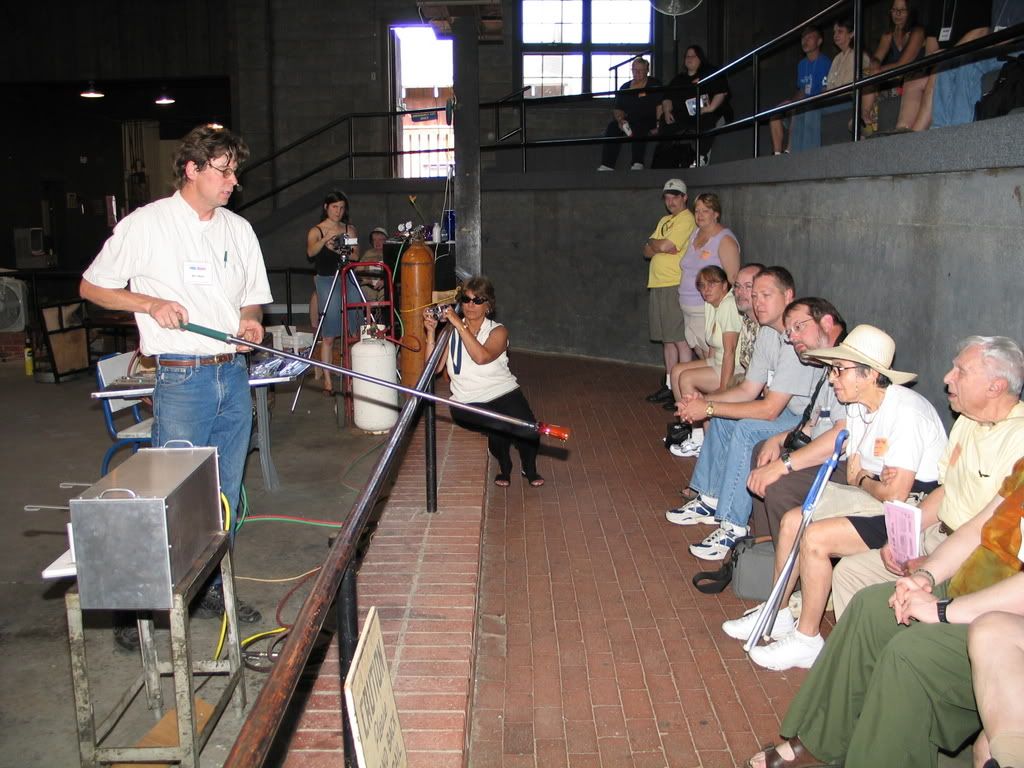
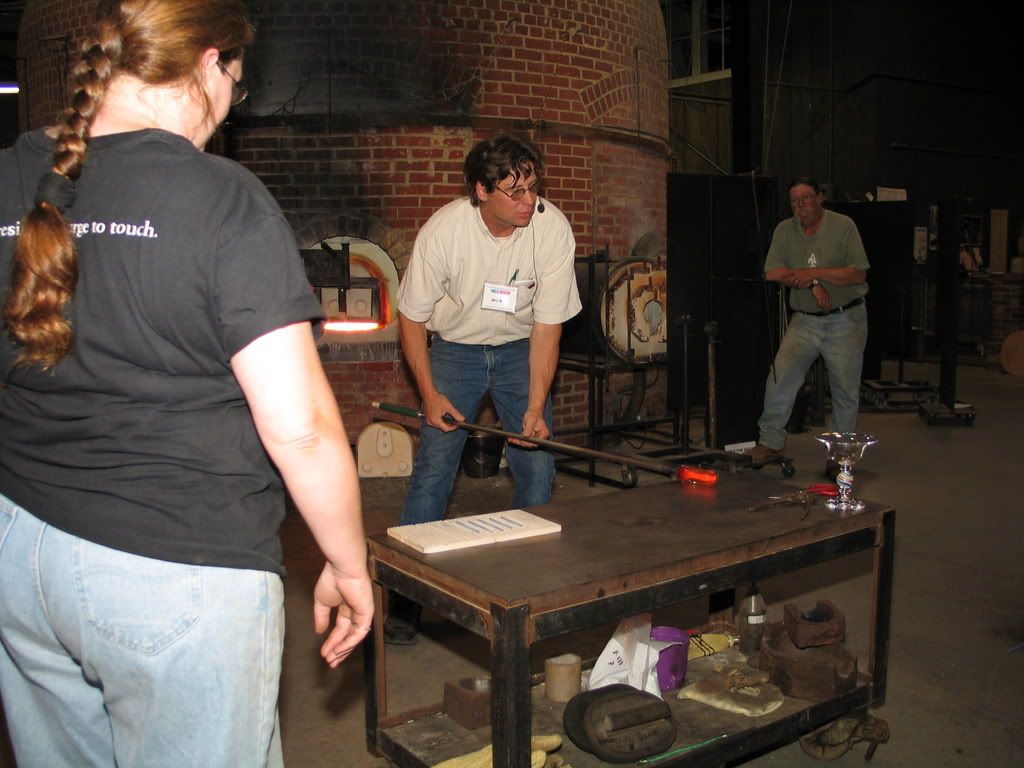
The gaffer will use calipers to know the circumference of the cylinder and will adjust towards a specific circumference. That circumference is important for the next step - picking up individual thin color rods that will form the latticinio core.
The color rods are placed on a marver plate (usually steel) with parallel grooves to hold the color rods to be picked up. The rods are heated by an assistant to bring them to a temperature similar to that of the cylinder to allow them to adhere and to avoid temperature shock.
An assistant heats the color rods on a white grooved marver plate:
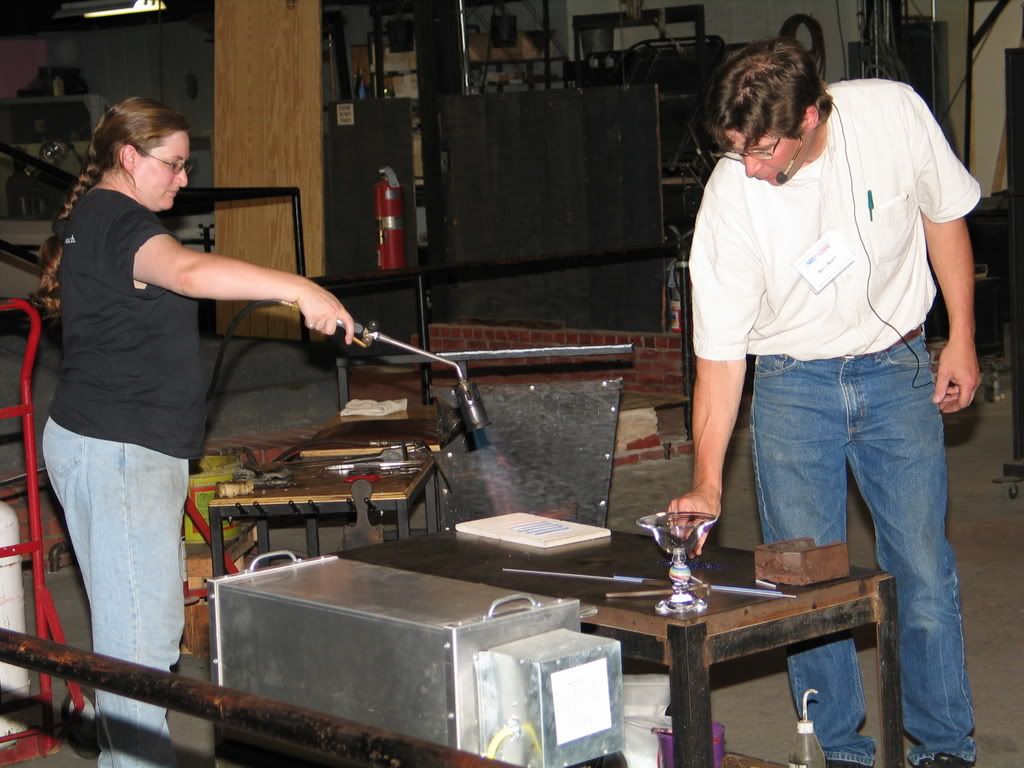
When the cane cyliner is the right dimension - it is laid on the end of the grooved marver and slowly rotated across the face of the marver - picking up the latticinio rods. If the dimension is correct - the rods will be evenly spaced after the last one is picked up (if not - there will be a gap).
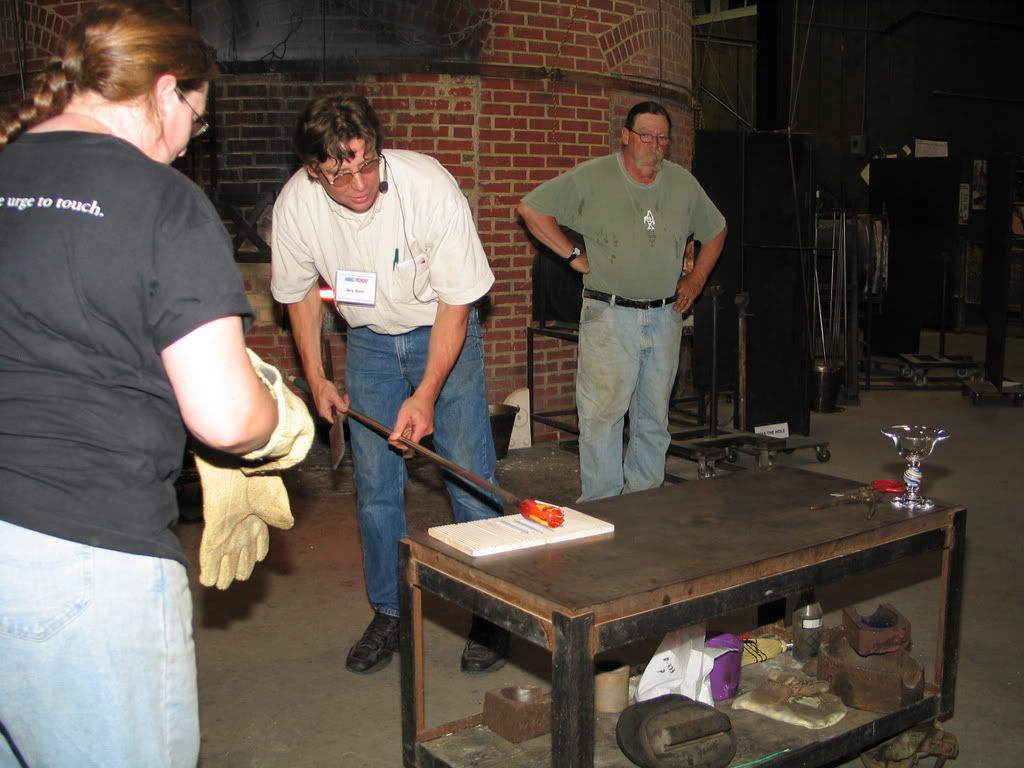
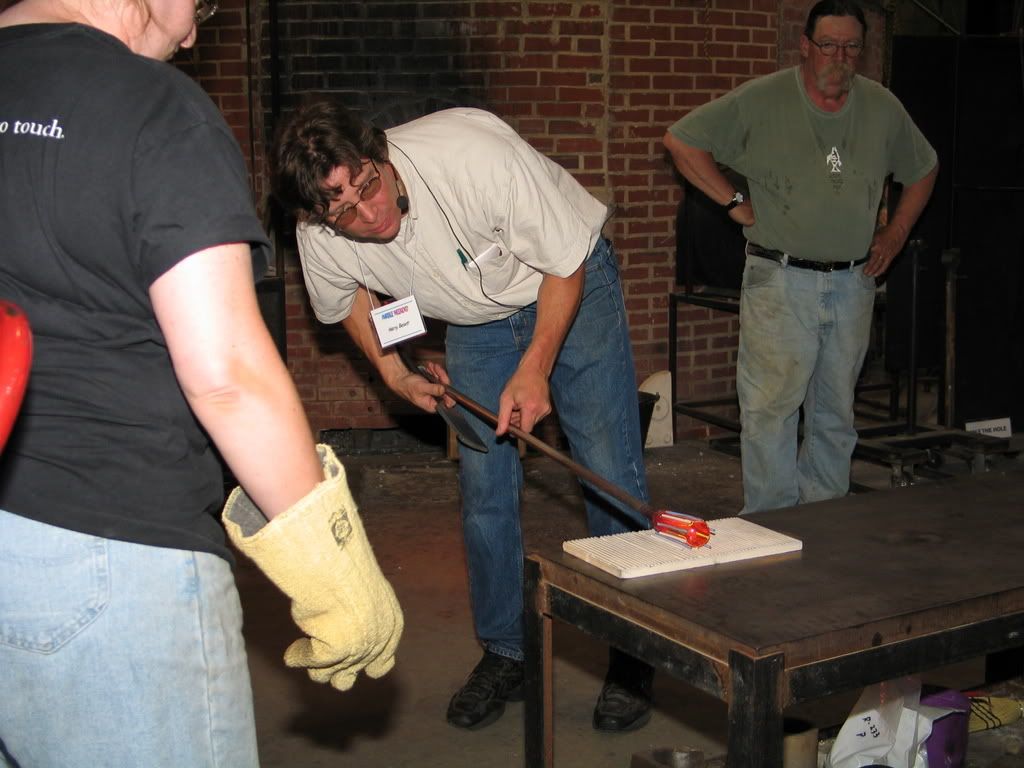
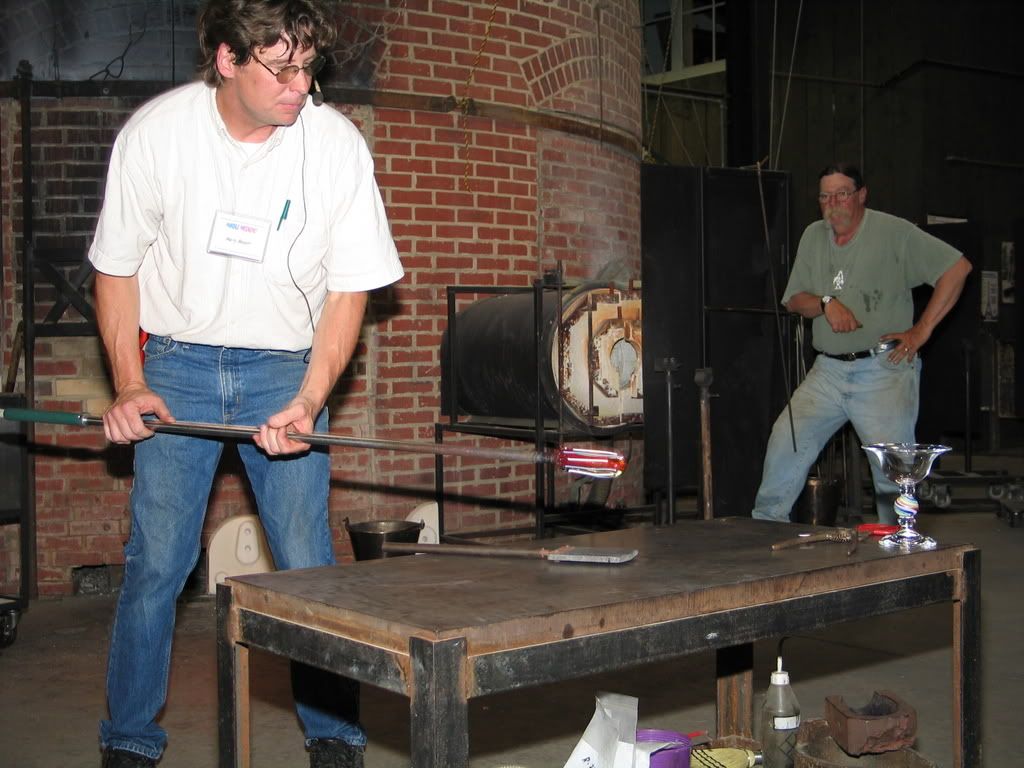
The cylinder and rods will go into the gloryhole to be heated together and go to the steel marver table to be pressed together evenly. Then back to the gloryhole.
Another gather of clear is made on to of the core rods. Rememer that the cylinder is still quite thick - 4-6" or so. If you look closely you can see the latticion core color rods inside the clear:

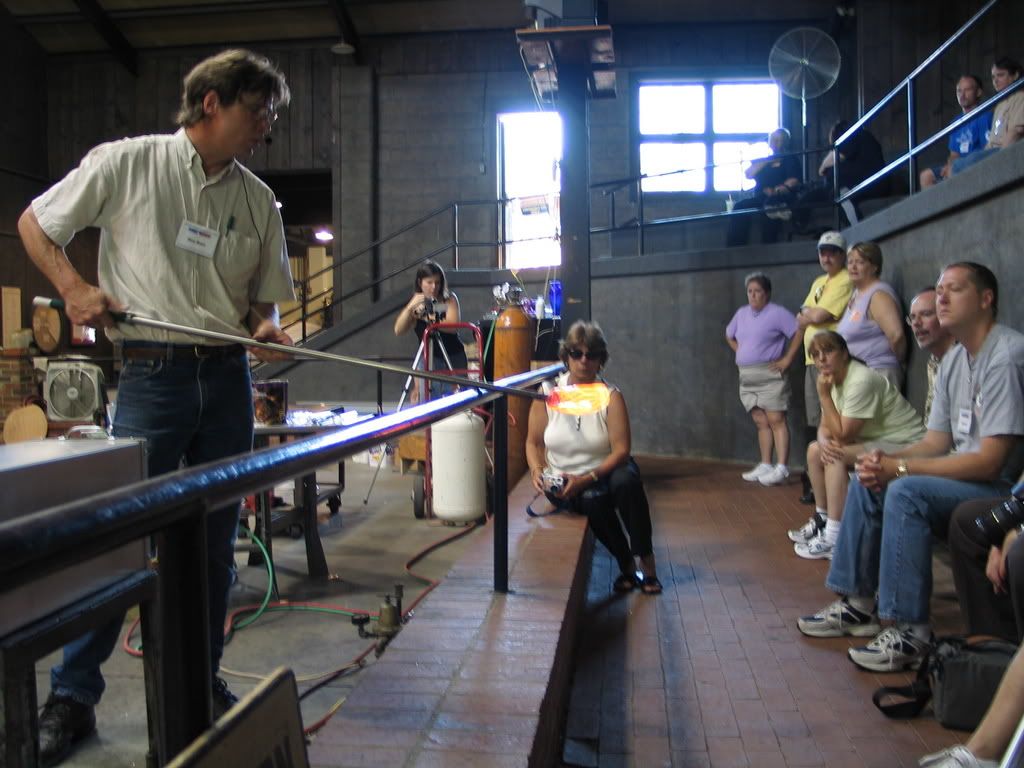
If it is a two stage piece (outer bands) - the artist will prepare to pick up outer color rods (which may also become flattened ribbons) in the same way the core was set-up on a grooved marver plate. The outer rods are picked up, heated, rolled on the marver and one last gather of clear is collected from the pot. This is now rolled into a even cylinder.
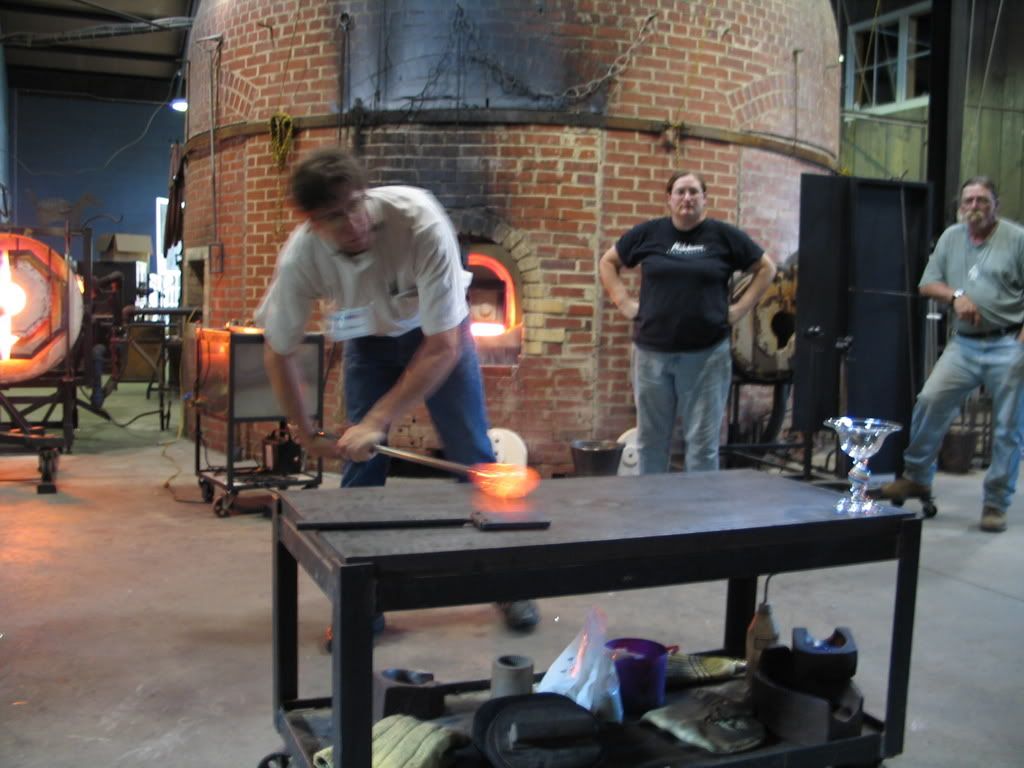
Back into the glory hole for re-heating:
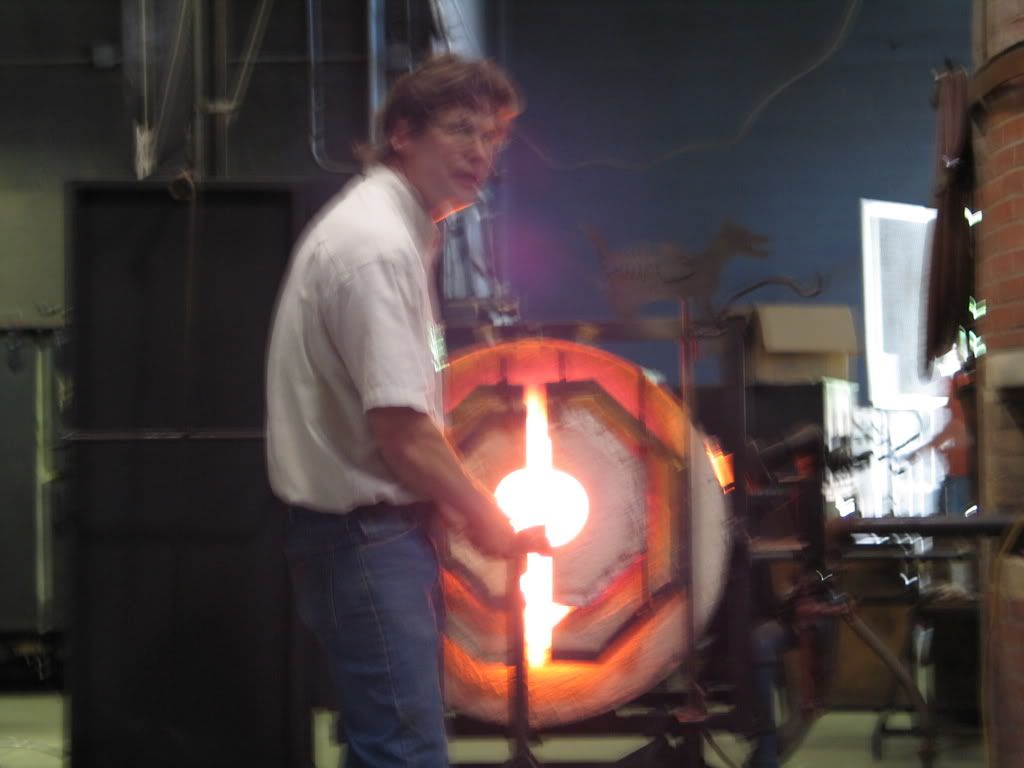
Back to the marver for shaping and smoothing:

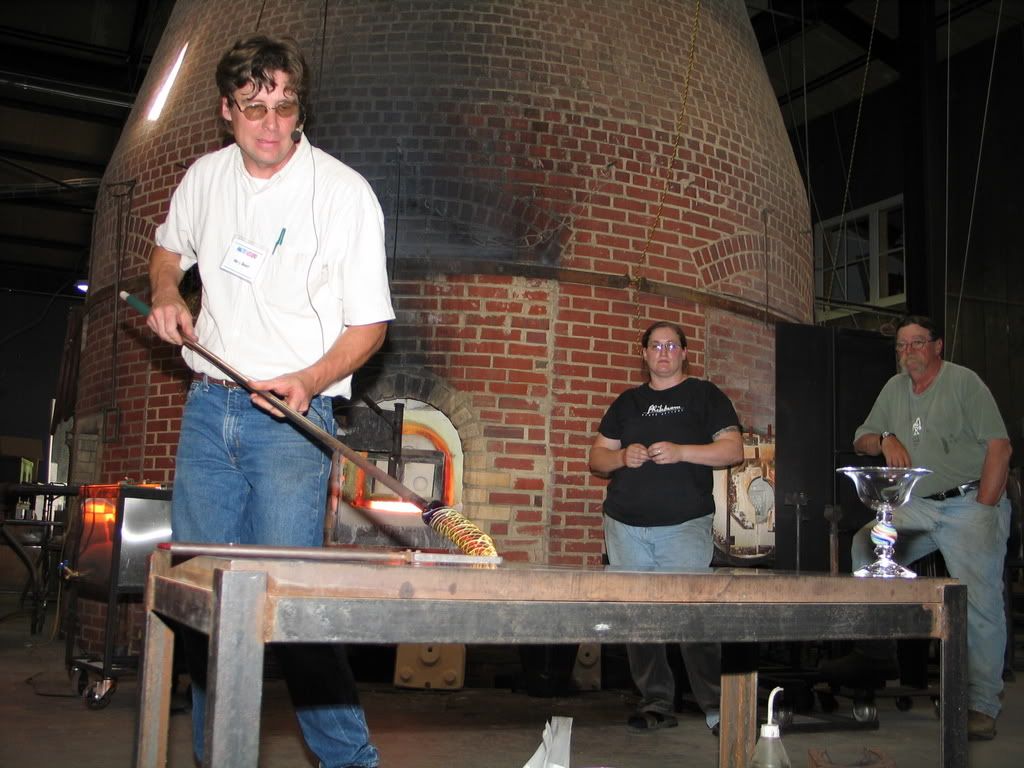
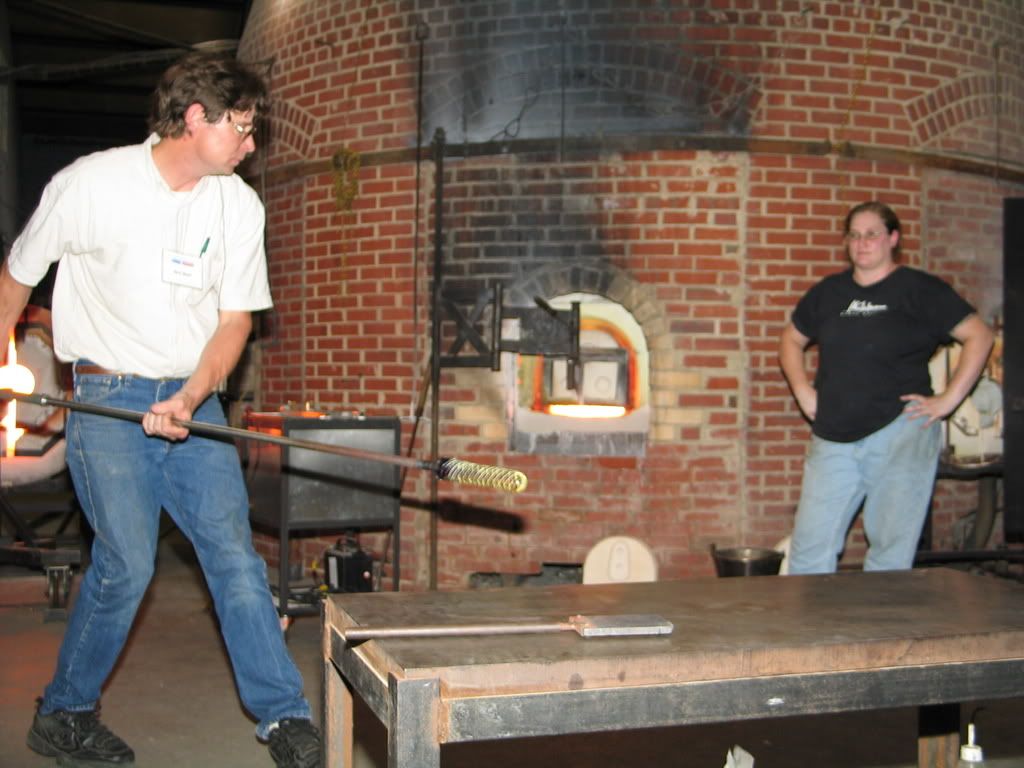
Here is a pic of Geoff Beetem using the marver:

That cylinder is likely larger in diameter than the desired marbles - so it is "pulled down" to a smaller diameter. This is done by re-heating it evenly (end to end) and having an assistant grasp the end of the thick cane with a tool and pulling in opposite directions until the desired diameter is reached.
(This pic is of pulling murrini cane - but it is the same process)
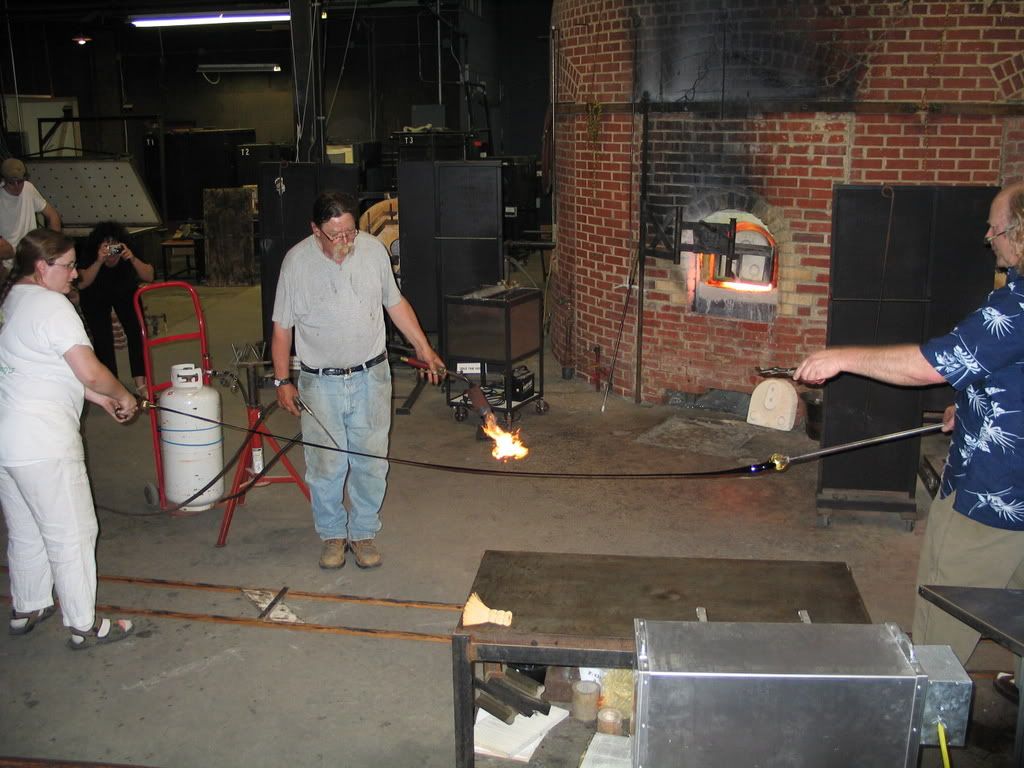
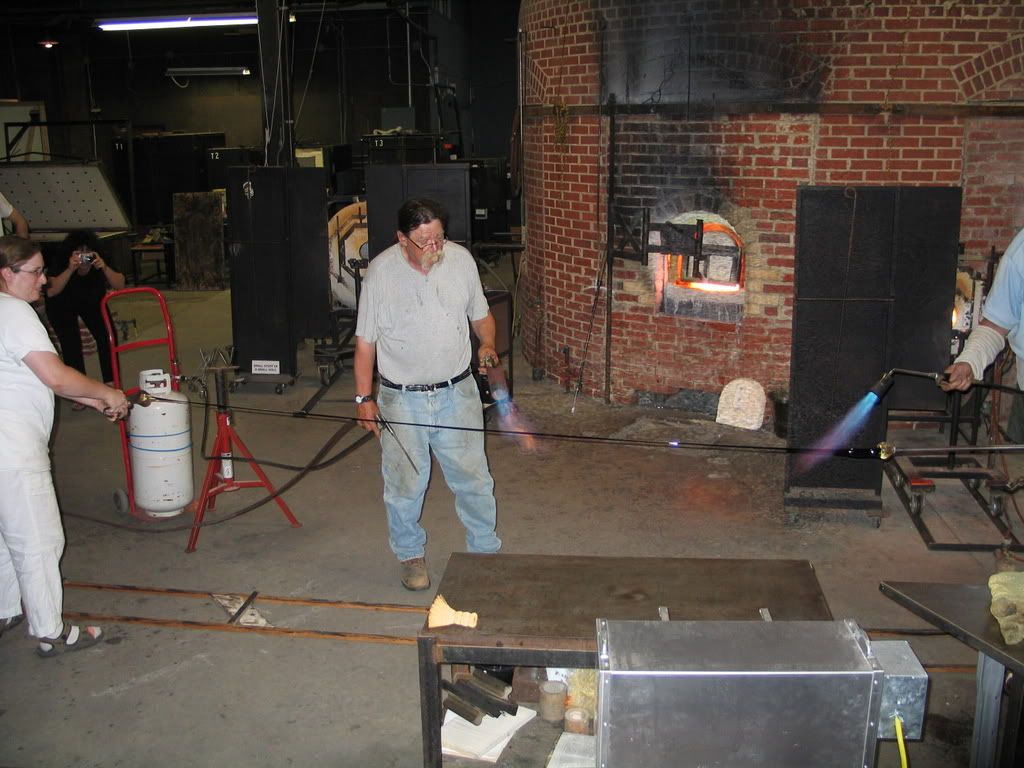
The artist then uses glass shears to cut off the end of the cane - which is a somewhat ragged collection of colors and uneven glass. That new "end" of the cane is the start of a marble and is rounded into a sphere by use of a wet hardwood cup.
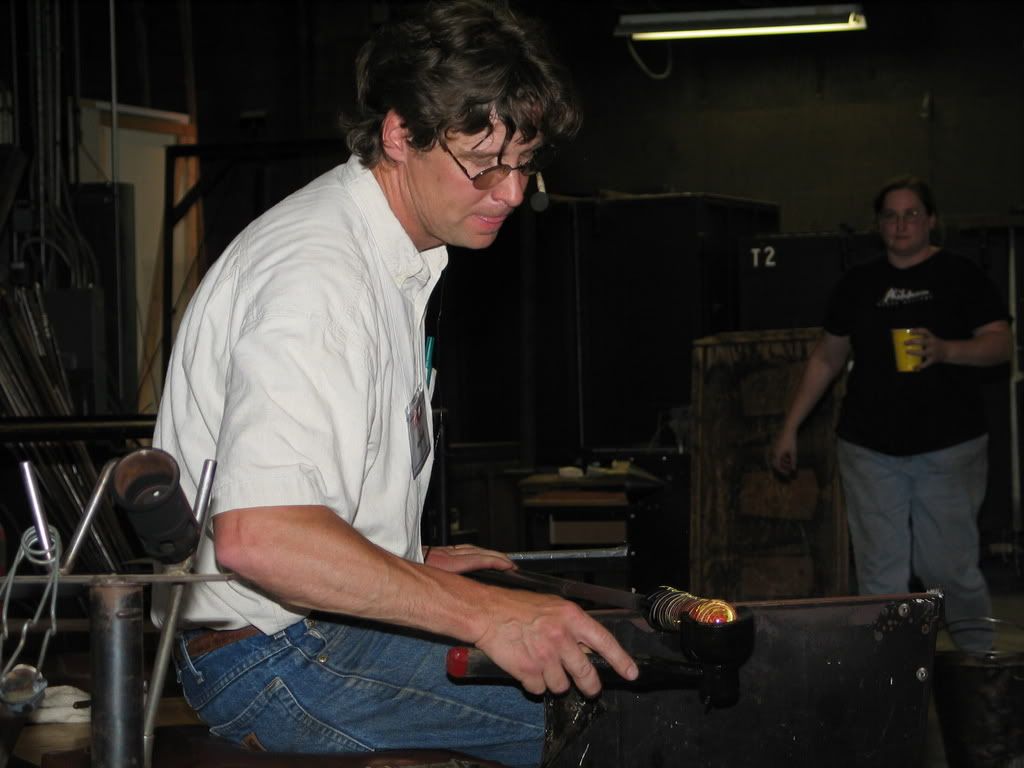
The artist then sits and uses a pair of jacks to begin narrowing the cane at a point by constantly revolving the punty - back and forth (remember that the cylinder of glass is hot and fairly soft). This continues until the marble takes its spherical shape.
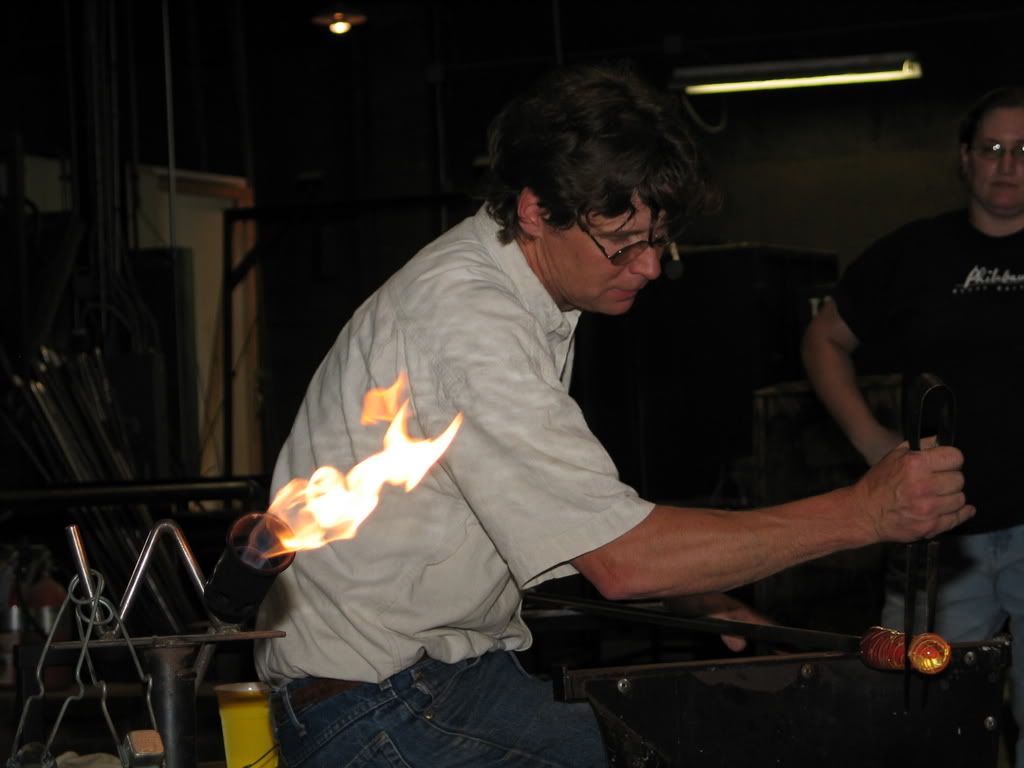
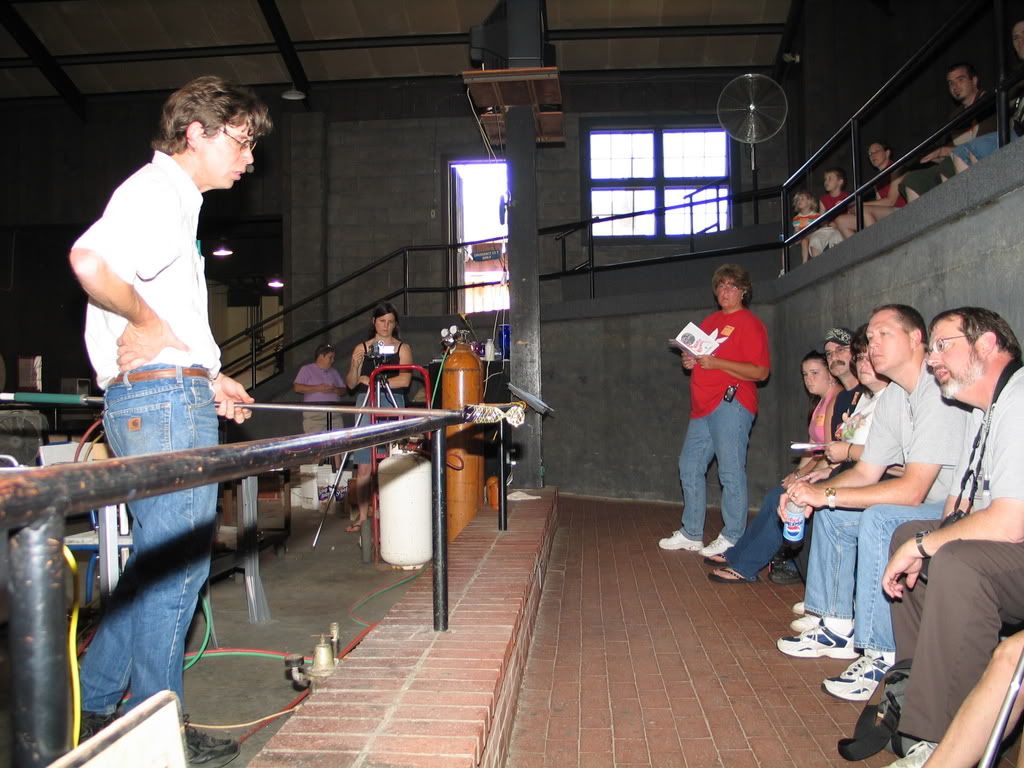
Geoff Beetem:
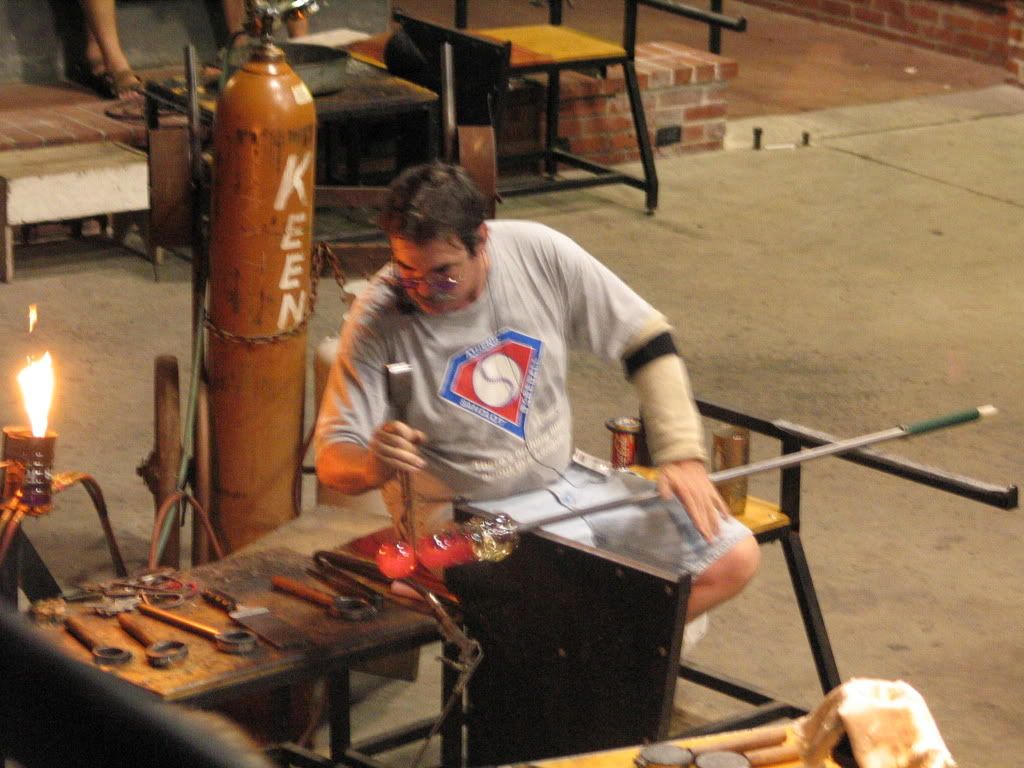
The "neck" of the marble narrows until the artist is ready to remove it from the cane like this:
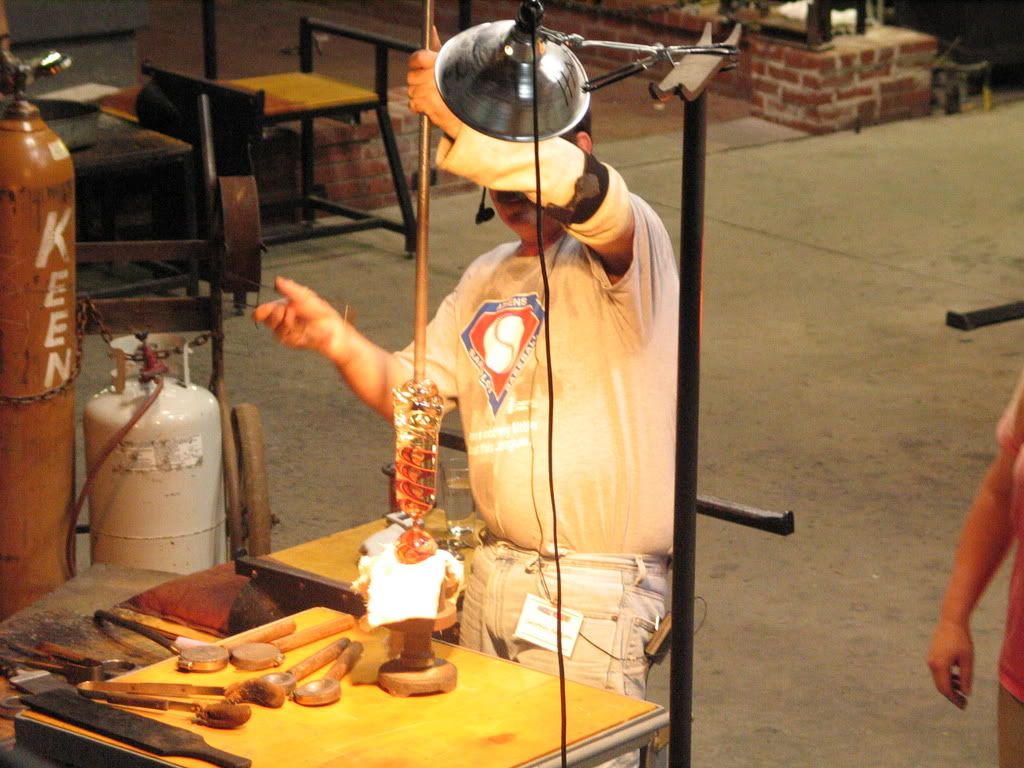
Geoff Beetem fire polishing the pontil:

Voila - a new handmade marble!
Hope this helps!
Alan
-
I can't say for sure without handling it - but it apears to be handgathered slag-ish to me. The photos are marginally lit so I can't be sure - but I don't see details that would lead me to believe that the red is oxblood.
-
jlmoriarty said:Great tutorial Alan. That is a post that is real archival material. Thanks for the effort.
Any idea how many "types" you are missing?
John
It genuinely pains me to choose to do this as this thread has been a great help to many people over the years with validated Ravenswood examples for them to compare their unknown marbles to, but:
(Unfortunately, I have chosen to remove this content due to unchecked, uncorrected bad behaviors by members on this board. The Moderators have chosen to allow such provocations, call-outs and offensive writings by members known for doing this. My apologies to those who will not benefit from this thread in the future. I put a great deal of time into creating this thread and accompanying quality photos it as a community member trying to help others. This support to the board community is apparently not valued.)
-
Wow, that's really interesting stuff! I sort my machine mades by "some of these don't quite look like the others" and a couple in question almost look like some that you've posted, in my opinion. I may have posted these pictures before, what do you think?
OK, been a while since I posted a pic here...let's try this again
From part II, and yes those green/red/black ones are cool too
I would say that the marble on the right is a definite. The one on the left is a little hard for me to get a feel for - so I would have to withold a call on it.
Alan
-
It genuinely pains me to choose to do this as this thread has been a great help to many people over the years with validated Ravenswood examples for them to compare their unknown marbles to, but:
(Unfortunately, I have chosen to remove this content due to unchecked, uncorrected bad behaviors by members on this board. The Moderators have chosen to allow such provocations, call-outs and offensive writings by members known for doing this. My apologies to those who will not benefit from this thread in the future. I put a great deal of time into creating this thread and accompanying quality photos it as a community member trying to help others. This support to the board community is apparently not valued.)
You are free to use these photos without restriction for your personal uses but they may not be used on/in for-profit websites or publications. Contact me if you have a question.
-
 1
1
-
-
It genuinely pains me to choose to do this as this thread has been a great help to many people over the years with validated Ravenswood examples for them to compare their unknown marbles to, but:
(Unfortunately, I have chosen to remove this content due to unchecked, uncorrected bad behaviors by members on this board. The Moderators have chosen to allow such provocations, call-outs and offensive writings by members known for doing this. My apologies to those who will not benefit from this thread in the future. I put a great deal of time into creating this thread and accompanying quality photos it as a community member trying to help others. This help is apparently not valued.)
Part V
A mix of Ravenswood greens - transparents and mostly opaques:
Two very nice transparent blues - which may be variants of the 4 posted in the premium group:
More transparents:
Shifting to opaques once again:
I found these mixed with the common Ravenswood swirls that came from the 1987 find crates.
End Part V
-
It genuinely pains me to choose to do this as this thread has been a great help to many people over the years with validated Ravenswood examples for them to compare their unknown marbles to, but:
(Unfortunately, I have chosen to remove this content due to unchecked, uncorrected bad behaviors by members on this board. The Moderators have chosen to allow such provocations, call-outs and offensive writings by members known for doing this. My apologies to those who will not benefit from this thread in the future. I put a great deal of time into creating this thread and accompanying quality photos it as a community member trying to help others. This help is apparently not valued.)
Continuing the transparent varieties:
End Part IV
-
It genuinely pains me to choose to do this as this thread has been a great help to many people over the years with validated Ravenswood examples for them to compare their unknown marbles to, but:
(Unfortunately, I have chosen to remove this content due to unchecked, uncorrected bad behaviors by members on this board. The Moderators have chosen to allow such provocations, call-outs and offensive writings by members known for doing this. My apologies to those who will not benefit from this thread in the future. I put a great deal of time into creating this thread and accompanying quality photos it as a community member trying to help others. This help is apparently not valued.)
-
It genuinely pains me to choose to do this as this thread has been a great help to many people over the years with validated Ravenswood examples for them to compare their unknown marbles to, but:
(Unfortunately, I have chosen to remove this content due to unchecked, uncorrected bad behaviors by members on this board. The Moderators have chosen to allow such provocations, call-outs and offensive writings by members known for doing this. My apologies to those who will not benefit from this thread in the future. I put a great deal of time into creating this thread and accompanying quality photos it as a community member trying to help others. This support to the board community is apparently not valued.)
Also in the premium classification group are gray swirls.
The next premium type is an opaque white based swirl ...
The next premium type is a Ravenswood version of a Coral.
The next premium type is a clear matrix with bright blue and white swirls
The last premium type I'll be describing is a marble that didn't jump out at me when I fist saw it. It is a very dark cobalt blue marble that appears almost opaque....
This concludes premium types that I will cover in this writing - although there are a few more that exist.
End Part II
-
It genuinely pains me to choose to do this as this thread has been a great help to many people over the years with validated Ravenswood examples for them to compare their unknown marbles to, but:
(Unfortunately, I have chosen to remove this content due to unchecked, uncorrected bad behaviors by members on this board. The Moderators have chosen to allow such provocations, call-outs and offensive writings by members known for doing this. My apologies to those who will not benefit from this thread in the future. I put a great deal of time into creating this thread and accompanying quality photos it as a community member trying to help others. This support to the board community is apparently not valued.)
-
Definitely something special going on with that glass. Is there any hint at all of bleeding/blending?
None. The two glasses have different densities and clearly the oxblood moves to the surface - which IMO suggest a higher density. I think the internal limited oxblood is pretty common with the exception of some of the clear oxblood "experimentals" that were dug at the factory. Those exhibit a good internal mix of oxblood - which make them fairly dark.
-
It seems that the subject of oxblood and how it covers, swirls or mixes with a marble's base glass comes up in threads with some regularity. I came across a batch of Akro milky oxbloods I acquired many years ago. In the group was a "throw away" that got tossed in - with a heavy fracture through it. I popped it in half by hand and the resulting photos of the outside versus the inside speaks volumes about oxblood density and how it tends to move and spread to the surface. I thought I would share this since most of us won't encounter broken oxblood marbles.
The outside:
and the inside...
(Unfortunately, I have chosen to remove this content due to unchecked behaviors by others on this board. My apologies to those who will not benefit from it in the future.)
-
-
Alan, I was hoping someone else would say something about this one.
How's it done?
I don't even know what to ask.
I only know it is fascinating.
They do a clear gather and create the first sphere - about 2". It is then annealed and cooled to room temperature. They then use glass paints to make the inner sphere artwork - placing art in specific places. I *think* they then fire the glass paint to the first sphere. Once fired they then put it in a kiln and slowly bring it back up to temperature, punty it up and do a clear gather over the first sphere - enough to give the 1st and 2nd layers depth.
It then gets knocked off the punty again, back into annealing and brought back down to room temperature slowly. The second layer of art is applied with "windows" in the apropriate places to see the art in the first gather. They fire the second layer of paint as before, ramp it back up in the kiln, punty it and then do a final clear gather over the 2nd layer of art.
As you can see - there is a lot of work in them.
They did a collaboration with Josh Simpson with head figures with open mouths with Simpson planets inside. Clear stars on the top of the head lit he planet. Pretty cool.
From their website:
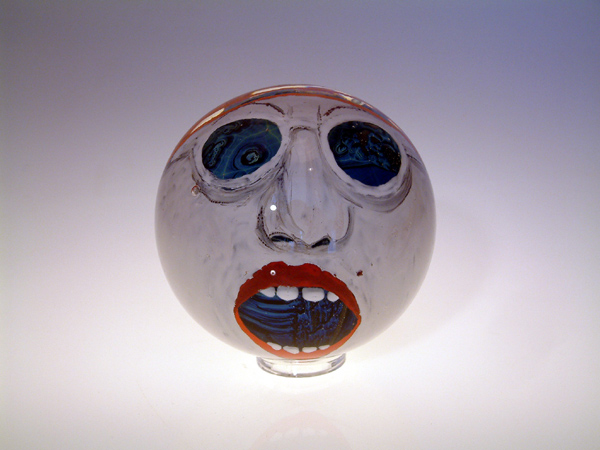
They are far more interesting in the hand than in photos.
-
I thought that I would share a Harry and Wendy Bessett collaboration with Ken Leslie. It is a large, two-stage piece, hand painted.
Enjoy!
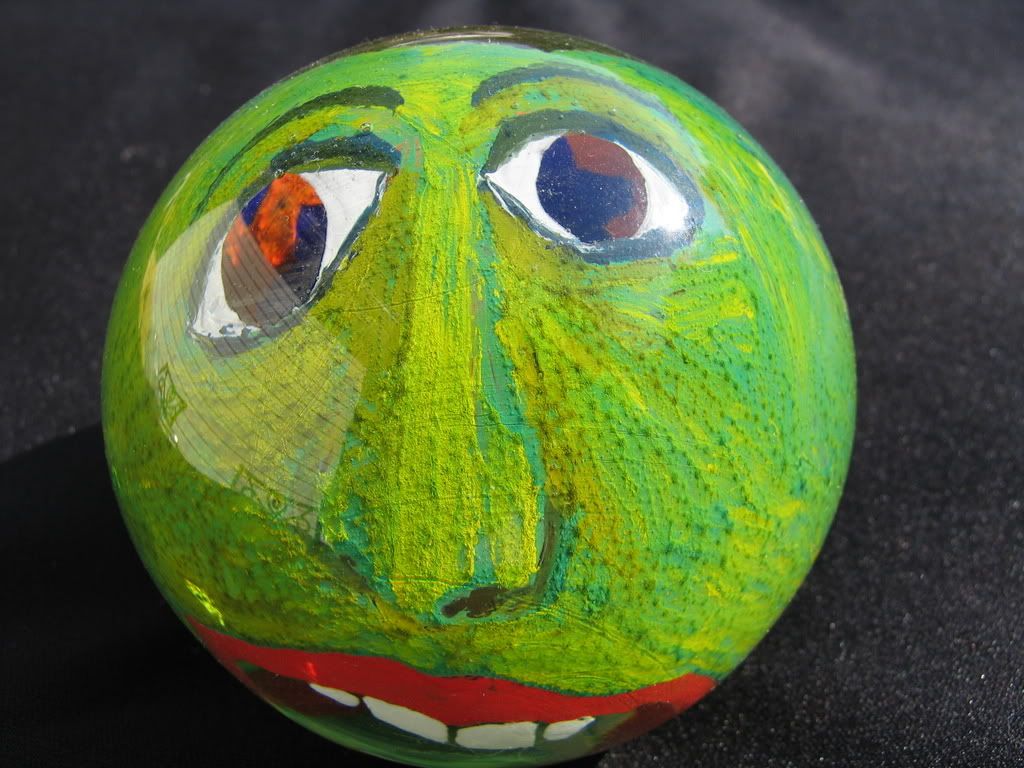
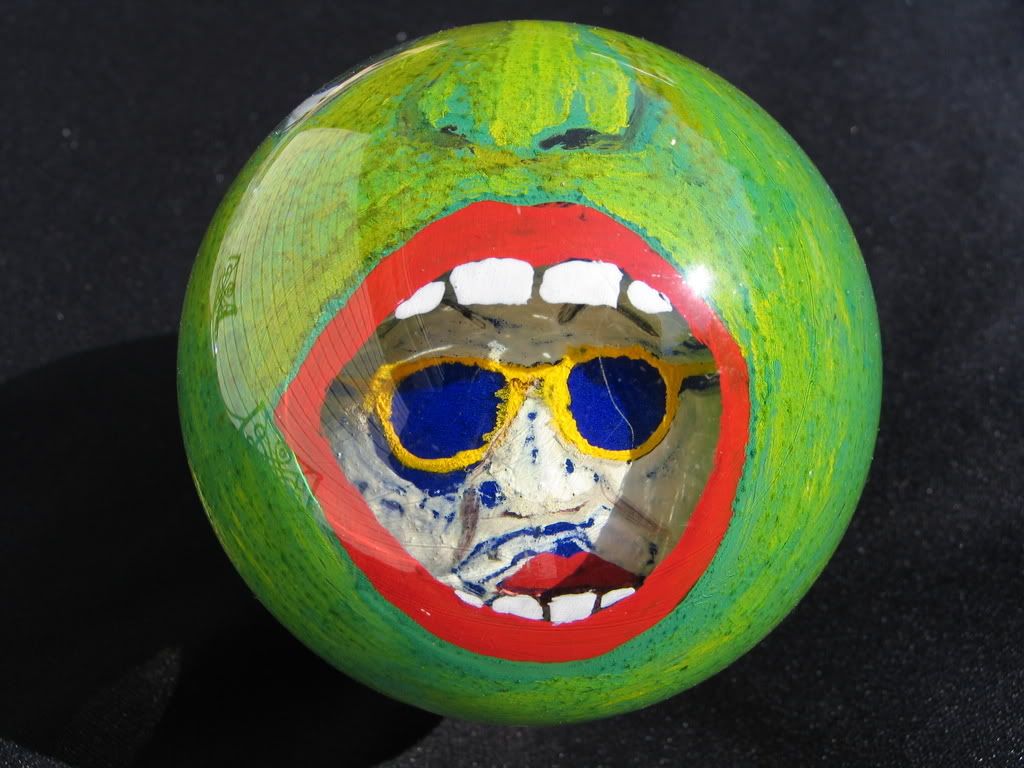

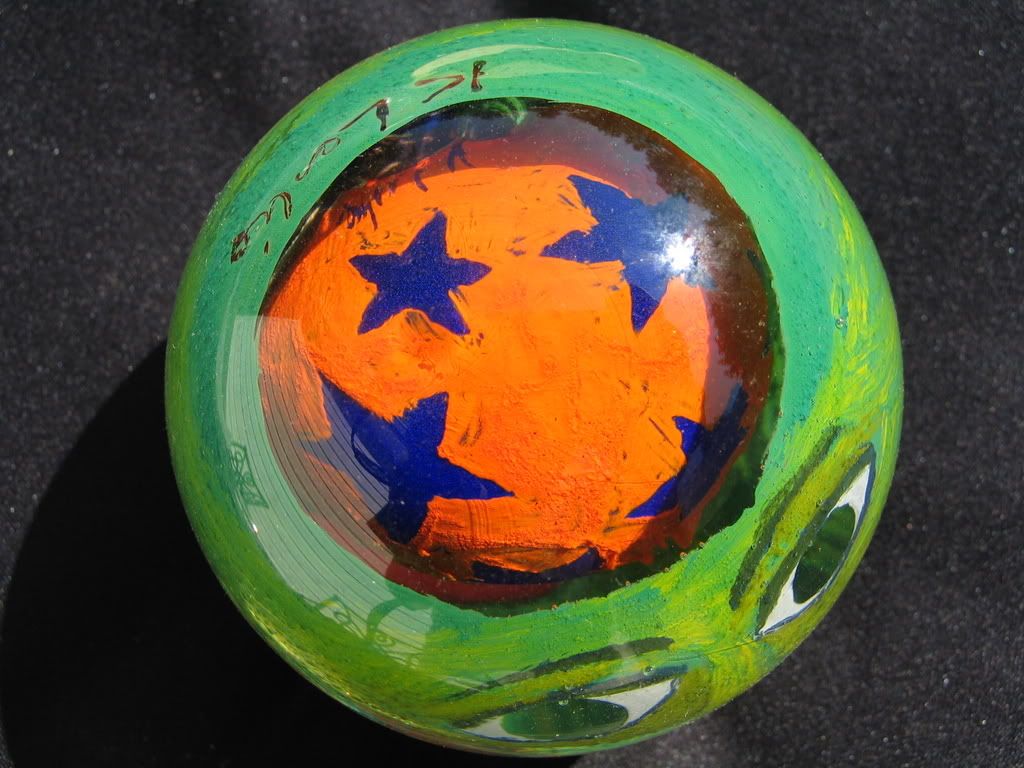



Alan's New Philly Show Picture Thread
in Archives
Posted
(Unfortunately, I have chosen to remove this content due to unchecked behaviors by others on this board. My apologies to those who will not benefit from it in the future.)